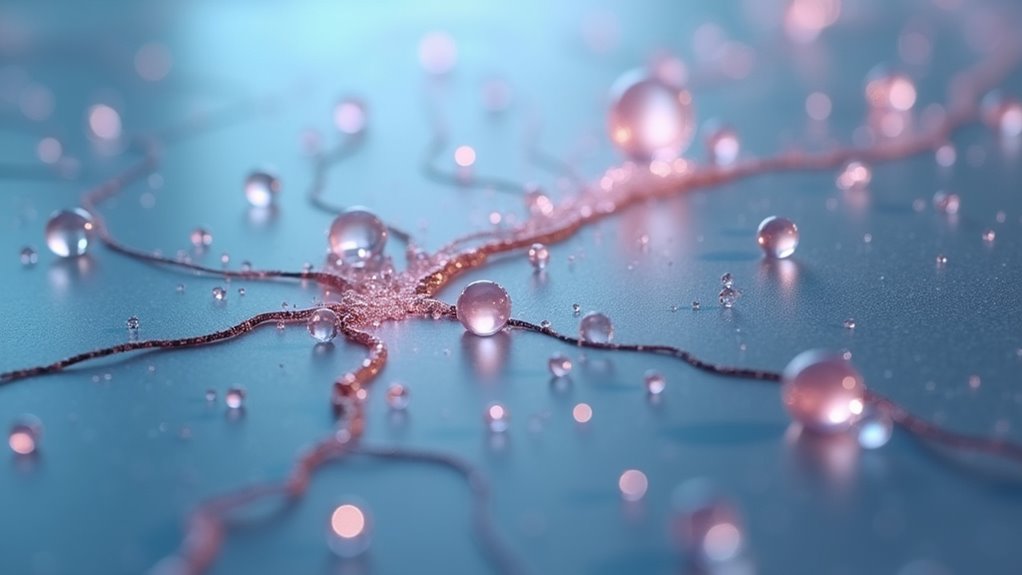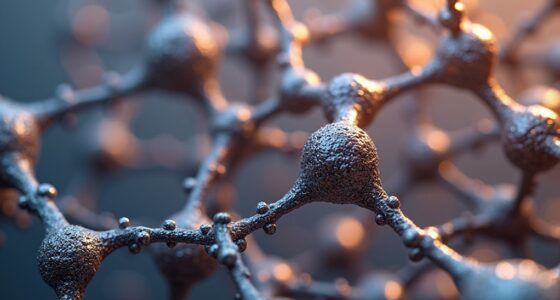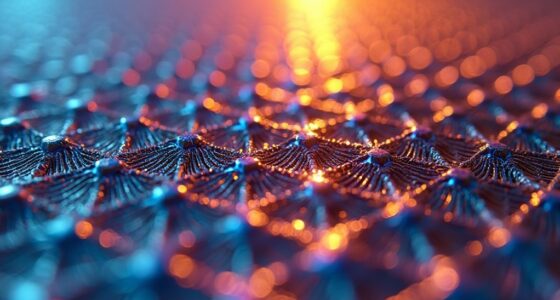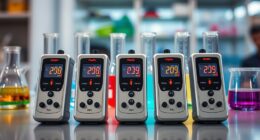Self-healing polymers are innovative materials that repair themselves after damage, which helps extend their lifespan and improve safety. They use different mechanisms, such as reversible bonds or microcapsules with healing agents, activated by stimuli like heat or light. These materials are used in electronics, coatings, automotive parts, and more. By understanding how these systems work and the latest advances, you can learn how self-healing polymers are transforming many industries and what future opportunities they hold.
Key Takeaways
- Self-healing polymers automatically repair damage, extending durability through intrinsic (reversible bonds) or extrinsic (microcapsules) mechanisms.
- Activation can be spontaneous or stimulus-driven, such as heat, light, or pressure, to trigger the healing process.
- Reversible chemical reactions like Diels-Alder or hydrogen bonds enable multiple repair cycles and enhanced material lifespan.
- Applications include protective coatings, flexible electronics, automotive parts, and biomedical devices, improving safety and sustainability.
- Challenges involve balancing mechanical strength with healing ability and developing scalable, cost-effective manufacturing methods.
Understanding Self-Healing Polymers and Their Significance
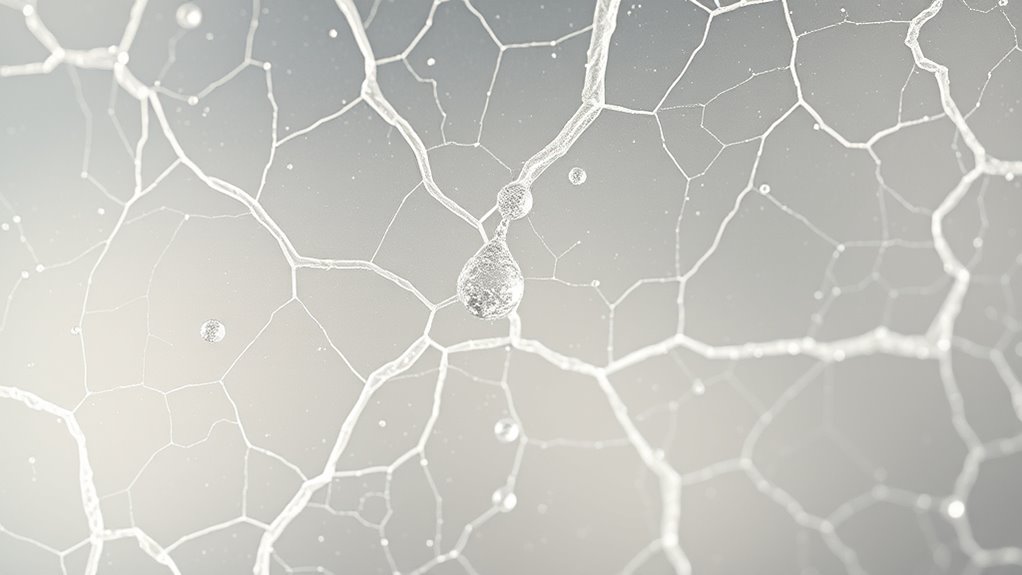
Self-healing polymers are innovative materials designed to repair themselves automatically when damaged, eliminating the need for human intervention. You can think of them as smart materials that detect and fix cracks or breaks without external help.
These polymers use different healing mechanisms: intrinsic systems rely on dynamic bonds within the material, while extrinsic systems contain microcapsules with healing agents that release upon damage. Activation can happen spontaneously or through stimuli like heat, light, or pressure. Features to consider include the type of healing mechanism and responsiveness to environmental cues.
This technology draws inspiration from living systems like human tissues that heal naturally. By extending a material’s lifespan and reducing maintenance costs, self-healing polymers improve durability and sustainability across industries such as aerospace, automotive, and electronics. Developments in encapsulation and chemistry strategies support these advancements, making self-healing materials more practical for widespread application.
Their ability to prevent failure makes them a game-changer in material science.
Core Mechanisms Behind Autonomous Repair in Polymers
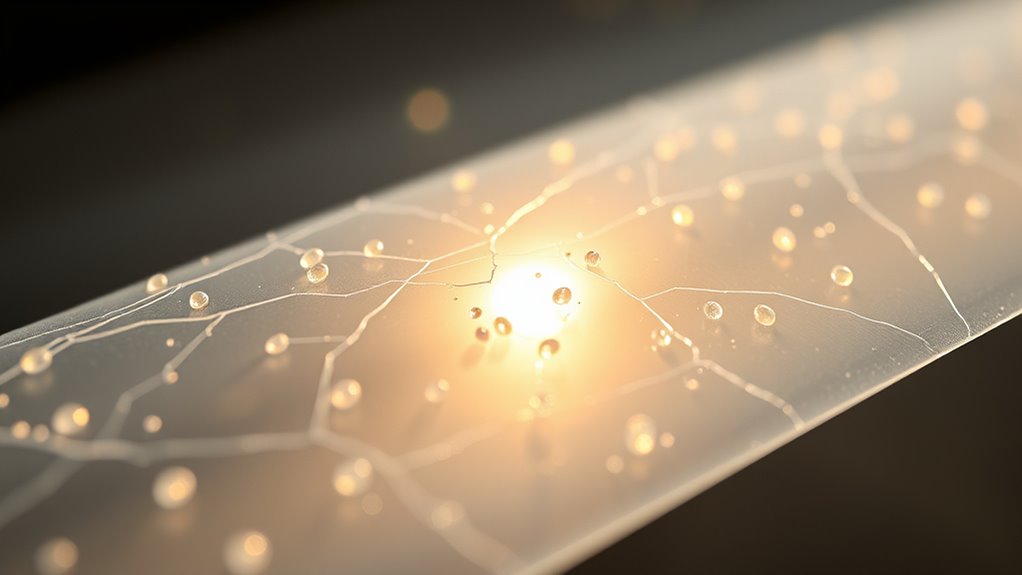
The ability of polymers to repair themselves autonomously hinges on two primary mechanisms: intrinsic and extrinsic. Intrinsic self-healing involves the polymer chains reforming dynamic bonds or interactions without added agents, relying on reversible bonds like hydrogen bonds, metal-ligand coordination, or covalent bonds. High chain mobility allows these chains to diffuse and reconnect at damage sites, restoring integrity. This process can be enhanced by designing polymers with specific dynamic covalent bonds that facilitate multiple healing cycles without degradation. Additionally, the reversible nature of bonds enables repeated repair processes, extending the lifespan of the material. Extrinsic mechanisms depend on embedded repair agents such as microcapsules or vascular networks that release healing chemicals when damage occurs. Microcapsules rupture and release agents directly into cracks, while vascular systems continuously supply healing materials. Both mechanisms enable autonomous repair, but their effectiveness depends on bond dynamics, chain mobility, and damage triggers.
Chemical Strategies Enabling Self-Healing Capabilities
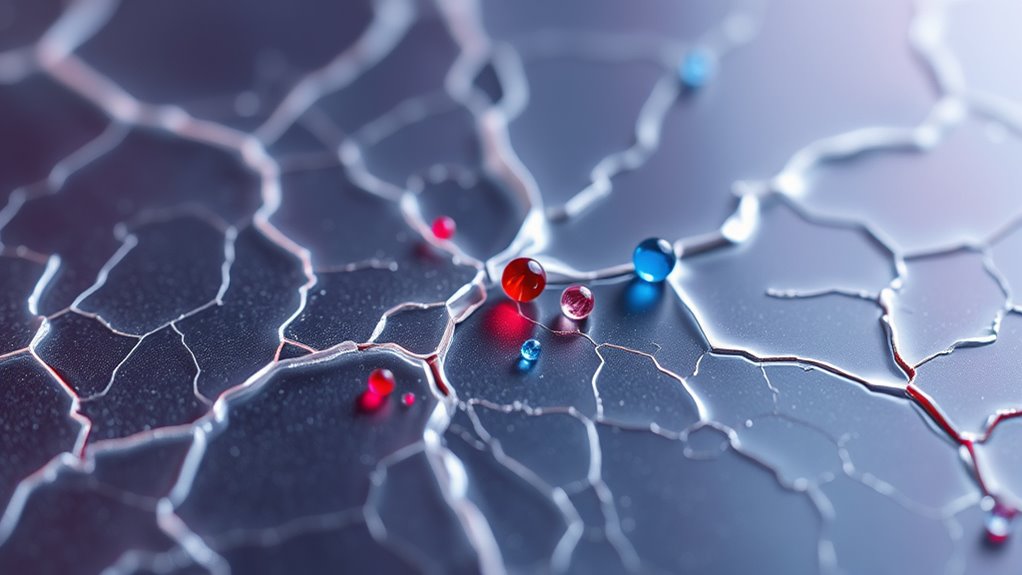
Have you ever wondered how polymers can repair themselves through chemical reactions? The key lies in reversible chemical reactions, which allow bonds to break and reform, enabling self-healing. Researchers are now using common, off-the-shelf compounds to simplify synthesis, making these materials more accessible. Dynamic bonds such as covalent and non-covalent interactions are essential for self-healing processes. For example, polyurethane-based polymers incorporate the Diels-Alder (DA) reaction, which can achieve high healing efficiency under mild conditions. Modifying the molecular structure at the atomic level improves both strength and healing capabilities. Using the DA reaction with near-infrared irradiation allows healing without high temperatures, enhancing practicality. These chemical strategies enable autonomous repair, reducing maintenance costs and extending material lifespan, all while balancing complexity and environmental stability. Understanding the chemical mechanisms is crucial for advancing self-healing technologies. This approach paves the way for more versatile, durable self-healing polymers across various applications.
Enhancing Performance and Efficiency of Self-Healing Materials
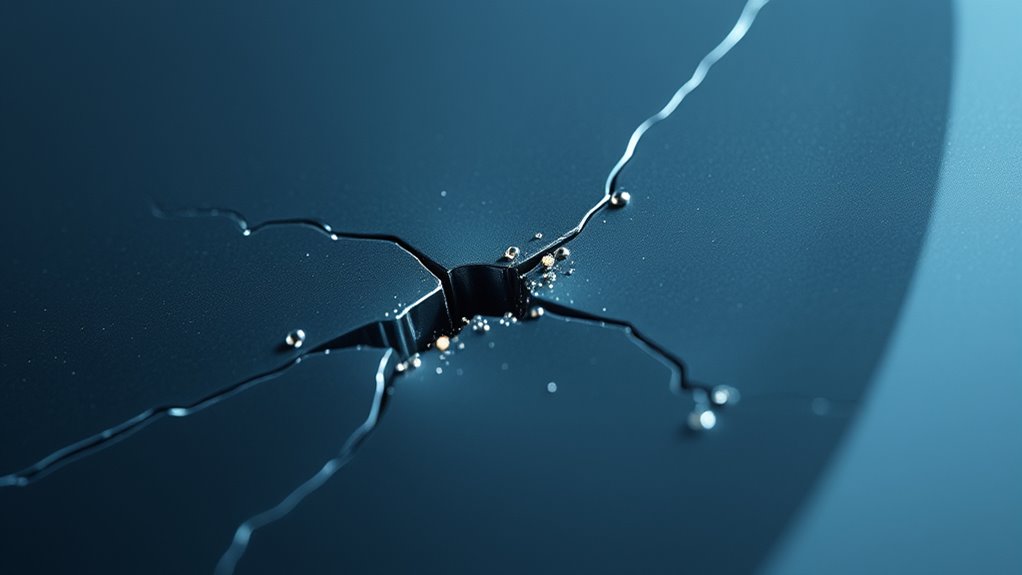
Enhancing the performance and efficiency of self-healing materials requires targeted strategies to optimize their mechanical strength and healing capabilities. To boost mechanical performance, you can increase tensile strength, stretchability, and toughness through molecular design and the use of fillers that improve resilience and modulus. Material selection and microcapsule design are crucial factors that influence self-healing efficiency, as demonstrated by the use of PMMA/epoxy microcapsules in cementitious systems. The recovery rate depends on factors like temperature, healing mechanisms, and environmental stability, which you can manipulate to accelerate healing and maintain strength over cycles. Improving healing efficiency involves thermal activation, NIR irradiation, and optimizing DA reactions, sometimes at ambient temperatures. Combining multiple healing mechanisms enhances repeatability and durability, especially when stable cross-links and catalysts are incorporated. Additionally, integrating architectural solutions can facilitate the development of self-healing building materials that adapt to environmental stresses.
Diverse Types and Practical Applications of Self-Healing Polymers
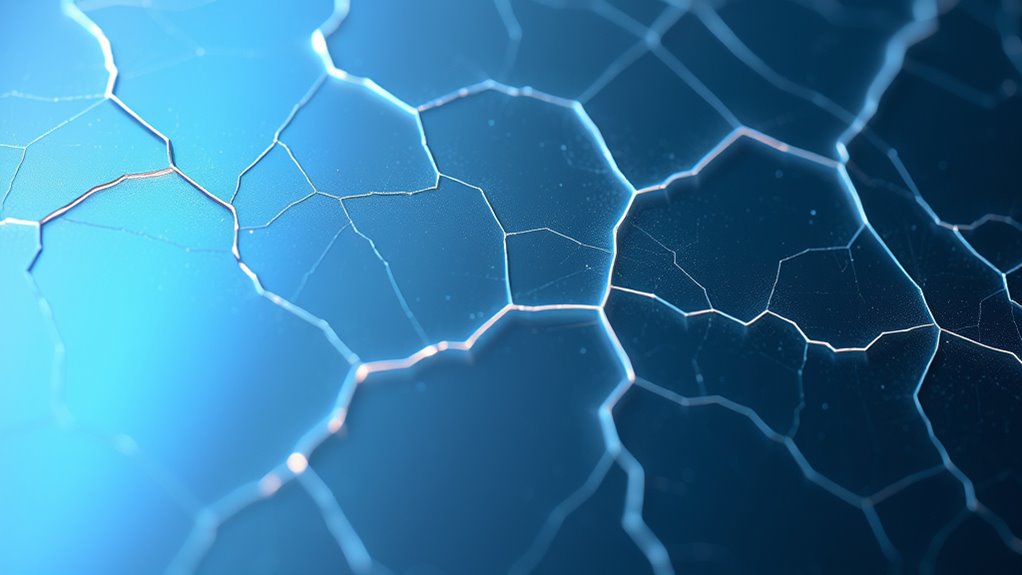
Self-healing polymers vary widely in their mechanisms and designs, each suited for specific applications and performance targets. Intrinsic systems heal through reversible bonds or physical interactions within the matrix, allowing multiple repairs without external additives. These systems can autonomously respond to damage without external intervention, making them highly versatile. Extrinsic systems depend on microcapsules or vascular networks that release healing agents upon damage, often enabling one-time repairs. Microcapsules filled with monomers or catalysts rupture to initiate polymerization, sealing cracks quickly. Vascular systems circulate healing agents repeatedly through microchannels, supporting multiple healings. Reversible covalent bonds, like Diels-Alder reactions, enable room-temperature self-repair by breaking and reforming bonds autonomously. Understanding these mechanisms is essential for designing durable materials. These diverse types find practical use in protective coatings, flexible electronics, automotive parts, medical devices, and smart textiles, enhancing durability and longevity across industries.
Environmental Benefits and Sustainability of Self-Healing Systems
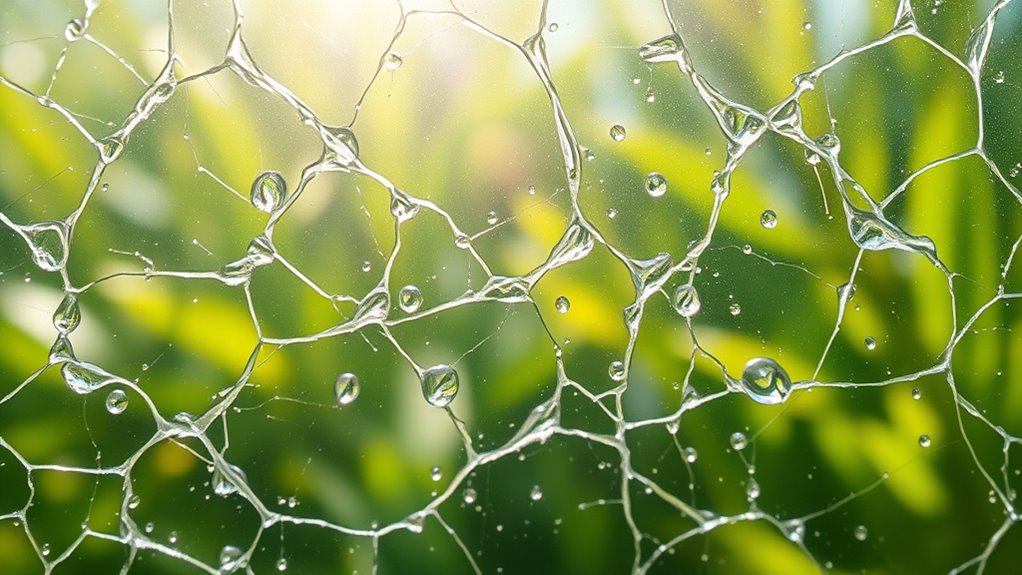
Self-healing systems offer significant environmental advantages by extending the lifespan of products and reducing waste. By minimizing the need for repairs and replacements, they cut down on manufacturing waste and lower resource consumption. Intrinsic self-healing mechanisms, such as reversible chemical bonds, are particularly effective in enabling these sustainable repairs. Longer-lasting materials decrease the environmental burden from plastic waste and manufacturing emissions, helping to protect ecosystems. In sectors like packaging, automotive, aerospace, and construction, self-healing materials boost durability, reducing disposal and maintenance impacts. Recent technological advances, such as improved synthesis and reversible chemical reactions, make production more sustainable. These innovations lead to simpler manufacturing processes and materials that require fewer resources. Additionally, advances in reversible chemical reactions contribute to reducing energy consumption during production, further enhancing environmental benefits.
Recent Innovations and Future Directions in Self-Healing Technologies
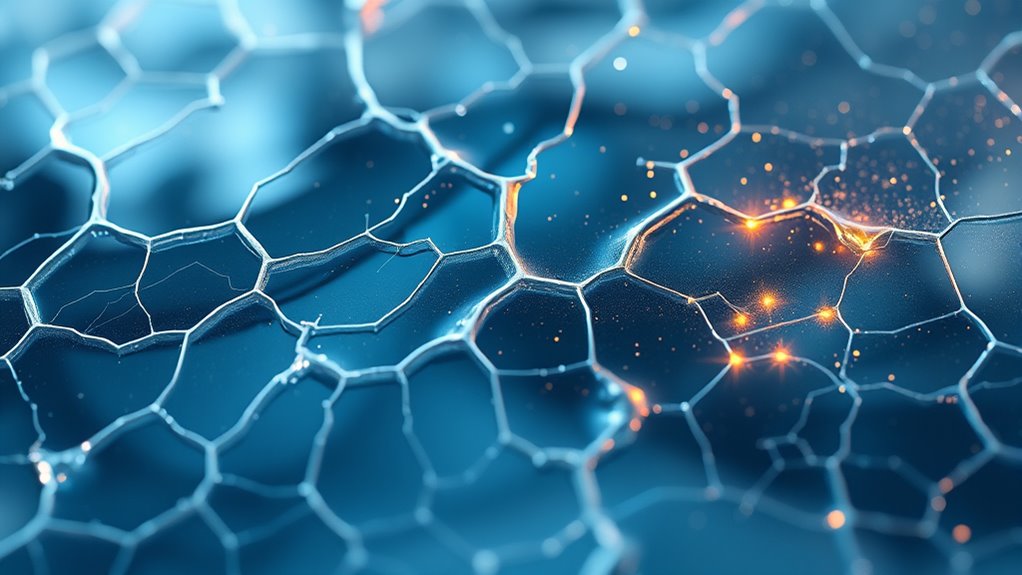
Recent innovations in self-healing materials are transforming how you approach durability and functionality across industries. Vitrimers, with their adaptable covalent bonds, enable thermally triggered self-repair through transesterification, combining epoxy-like resilience with repairability, ideal for durable coatings.
Supramolecular polymers rely on reversible non-covalent bonds, allowing autonomous damage repair while preserving strength, and are scalable via industrial methods like spin and dip coating.
Composite self-healing materials, such as graphene-polymer blends and micro-boron nitride-infused matrices, offer high strength, thermal stability, and quick healing, suitable for aerospace and electronics.
Advances also extend into food packaging, biomedical applications, and protective coatings, integrating damage detection and environmental responsiveness.
Future directions focus on multifunctional materials that combine mechanical repair with sensing, adaptability, and scalable manufacturing processes. Understanding polymer chemistry plays a crucial role in developing these innovative self-healing solutions.
Challenges and Opportunities in Developing Next-Generation Self-Healing Materials
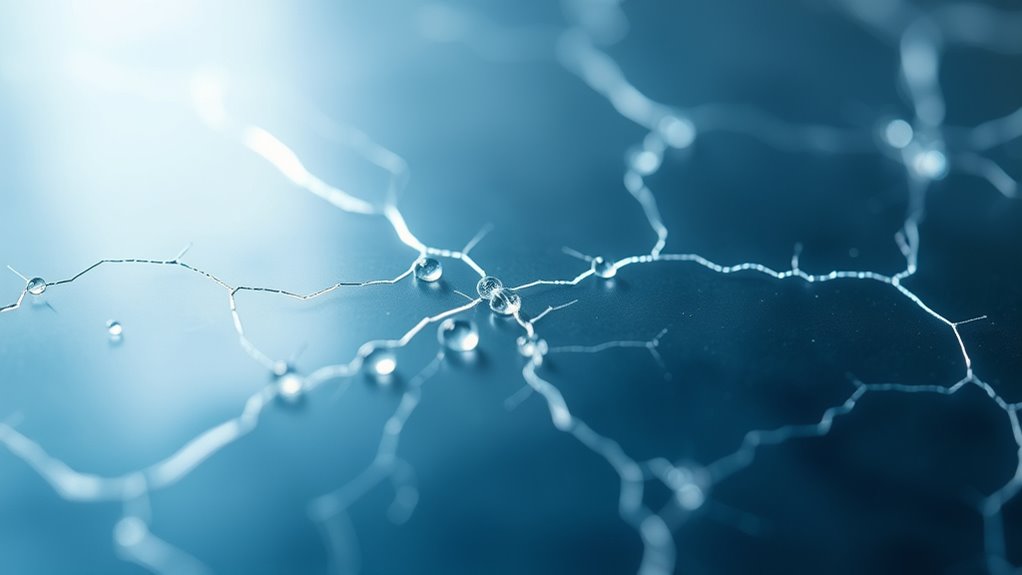
Advancing next-generation self-healing materials faces numerous hurdles that can hinder their widespread adoption. Achieving autonomous, efficient healing without external stimuli is difficult because it requires complex molecular interactions.
Balancing mechanical strength and healing ability remains a challenge; improving one often weakens the other. Repeated healing without losing effectiveness is tough due to healing agent depletion and material fatigue.
Incorporating microcapsules can interfere with primary properties and manufacturing processes. Controlling healing reaction rates at ambient conditions is also problematic, limiting practical use.
High production costs, expensive raw materials, and scaling issues further impede commercialization. Additionally, a lack of standardized testing methods makes it hard to compare materials objectively.
Furthermore, integrating personal growth principles such as resilience and adaptability may enhance the development of more durable and versatile self-healing polymers.
Overcoming these challenges opens opportunities to create durable, cost-effective, and versatile self-healing polymers for diverse industries.
Frequently Asked Questions
How Long Do Self-Healing Polymers Typically Retain Their Repair Capabilities?
You might wonder how long self-healing polymers keep their repair abilities. Typically, their capacity lasts through many cycles, often over 100, thanks to reversible bonds that enable repeated healing.
However, environmental factors like UV exposure, moisture, and mechanical stress can gradually reduce this ability. To maximize longevity, you need to maintain ideal conditions, such as proper chemistry and minimal damage accumulation, ensuring the polymer keeps healing effectively over time.
Are Self-Healing Materials Suitable for Use in Extreme Environmental Conditions?
You might wonder if self-healing materials work well in extreme environments. Some advanced polymers and ceramics now withstand high temperatures above 240 °C, maintaining their healing abilities.
They also offer robustness against mechanical stress and environmental factors like UV or chemicals. While promising, it’s worth mentioning that research is ongoing, and not all self-healing materials perform reliably under all extreme conditions yet.
Can Self-Healing Polymers Be Recycled or Reused After Multiple Damage Cycles?
Isn’t it inspiring that you can give damaged materials a second chance? You’ll find that many self-healing polymers can be recycled or reused after multiple damage cycles, thanks to dynamic bonds like hydrogen and imine bonds. These bonds allow the network to rearrange and recover, maintaining strength.
While some conditions are needed, ongoing innovations make recycling these polymers more feasible, helping you build sustainable, durable solutions for various applications.
What Are the Cost Implications of Producing Self-Healing Materials at Scale?
You wonder about the cost implications of producing self-healing materials at scale. Currently, high raw material prices and complex manufacturing increase expenses.
However, as production scales and technologies mature, costs are expected to decrease substantially.
Investing in scalable infrastructure and developing simpler chemistries will help reduce costs further.
Ultimately, larger-scale production can make these innovative materials more competitive with conventional options, encouraging broader industry adoption and long-term savings.
How Do Self-Healing Polymers Perform Compared to Traditional Repair Methods in Durability?
Did you know self-healing polymers can recover up to 80% of their original strength after damage? Compared to traditional repair methods, they often outperform in durability by restoring properties and extending lifespan.
You’ll find they adapt better to stress, absorb shocks, and reduce the need for repeated repairs. This means you’ll enjoy longer-lasting, safer products that save money and resources over time, making them a smarter choice overall.
Conclusion
Imagine a world where your materials heal themselves instantly, never failing or breaking down—it’s almost too incredible to believe! Self-healing polymers are revolutionizing industries, making everything stronger, longer-lasting, and eco-friendly beyond your wildest dreams. As this technology skyrockets, you’ll witness a future where damage becomes a thing of the past, and your world is transformed into an unstoppable fortress of resilience. Get ready—self-healing materials are here to change everything forever!
